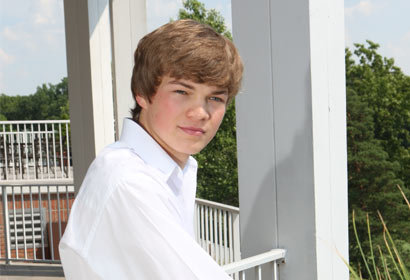Maybe it’s just baseball fever, but there was somethingclean and mighty, something Hank Aaron-like, about the way the Lansing SymphonyOrchestra and guest piano soloist Ivan Moshchuk got down to business at thesymphony’s season closer Tuesday night.
They could have fussed, spat tobacco and scratchedthemselves if they’d wanted to; the hyper-expressive music on Tuesday’s slateoffered plenty of opportunities for that. But Moshchuk, 19 years old, playedChopin’s second piano concerto with such clarity and fluidity the piano seemedto disappear.
We’re told the piano is a big box of hammers — a percussioninstrument — but Moshchuk played it as if it were a prism and his fingers werebeams. The notes were there, crisp and clean, but utterly thunkless.
 As one of two pianists designated as a Gilmore Young Artist this year by the prestigiousGilmore International Keyboard Festival, Moshchuk is on a heady victory lap of recitals andconcerts this spring, but he doesn’t act like it. Tuesday night, he might aswell have been alone in his room, communing with music he clearly loves. Hewasn’t out to conquer or charm, and that brought the audience even closer tohim.
As one of two pianists designated as a Gilmore Young Artist this year by the prestigiousGilmore International Keyboard Festival, Moshchuk is on a heady victory lap of recitals andconcerts this spring, but he doesn’t act like it. Tuesday night, he might aswell have been alone in his room, communing with music he clearly loves. Hewasn’t out to conquer or charm, and that brought the audience even closer tohim.
Not content with dissolving his own ego, Moshchuk alsomanaged to distill Chopin’s romantic self-absorption into a crystalline chainof emotional logic. Chopin puts up a tough front — he’ll throw in a few sternchords now and then, just to command your respect — but there’s a wet,undulating udder under his music most pianists can’t resist milking.
Moshchuk didn’t go for wet. Instead, he sprinkled rosin onthe floor and turned the concerto’s virtuosic runs and loops into a lean, lightballet. He played out enough line for the more languorous passages, but alwayskept the chain of logic taut. The disciplined emotion paid off in audienceattentiveness. Toward the end of the slow movement, Moshcuk sprinkled a fewnotes down, like snowflakes on a crisp December morning, and the effect was sobeautiful nobody in the hall dared to breathe, let alone cough.
The evening’s opener, “Too Hot Toccata” by Aaron Kernis, isone of those post-modern bon-bons that fuse a mouthful of eclectic flavors intoa ball, the way candy makers do these days. (White chocolate jalapeno wasabialmond M&Ms, anyone?) In this case, you get a sweet shell of prettymelodies, a second layer of chewy fugues, assorted licks of artificial jazz,and — surprise! — a sourball core of dissonant angst. Muffitt churned throughit all with dynamism and panache, overture style, leaving little trace exceptfor a feeling of relief that there is no full-length opera or musical to expandon such jittery, lightweight material.
“Lightweight” is not a word often linked with Beethoven’sFifth Symphony, the evening and season closer.
Never mind Chopin — here is classical music’s biggestmilking opportunity, a mammoth-sized cow with a blimp for an udder. Everyphrase is fraught with opportunities to hold a note longer, shake an extrafurious jowl, ratchet up the bombast.
Muffitt never took the bait.
He genuinely loves to restore a familiar masterwork to itsoriginal glory, and he does it honestly — not by layering his own coat ofpaint, just to make a mark, but by rolling up his sleeves and scouring down tobare wood.
It doesn’t hurt that Muffitt is a devoted fan of Beethoven’steacher, Haydn, and therefore is uniquely capable of finding the classical,dance-centered poise inside Beethoven’s stormy, personal music.
The Fifth’s famous opening movement rippled, pounded, ragedand breathed with a palpable humanity. All the way through, the brass sectionhas to trade “Da-da-da-doms” with the strings, and that’s a lot of potentiallydisastrous exposure, but they came through with absolute precision and, if anything,almost too much vigor.
There comes a point in this symphony where I find myselfwondering what it’s all about — usually during the processional march in thesecond movement.
The ceremony is noble and pleasing to the ear, but there’s ascary imperial boot in there. Maybe the last movement, with its earthier andmore spontaneous eruptions, is meant to eclipse the might of kings and emperorsby asserting the newfound power of the artist.
Then again – nah. As Muffitt and the LSO rolled out the lastmovement, building wave after wave of mighty momentum, I floated out of my bodyand saw a better answer, written high on the white pillars of the WhartonCenter, as clearly as the sponsors of this evening’s concert: This music isn’tabout anything but itself. It’s about the orchestra being a big hammer andBeethoven’s Fifth being a big nail. Sure, orchestras can play Ravel or Bach,the same way you can use a hammer to stir soup or play pool. But Tuesday night,at least, it was clear that Beethoven is the sweet spot, the strike zone, ofsymphonic music, where every slot fits into every tab, all cylinders arefiring, and nothing goes to waste. It’s where form and content fuse into agreat big kick in the ass and no other music will ever do.
I’m sure the feeling will pass before the next seasonstarts.
Support City Pulse - Donate Today!
Comments
No comments on this item Please log in to comment by clicking here